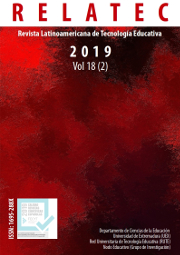Music Teachers’ Use of Online Video Platforms (OVPs) in Lesson Design and Instruction
DOI:
https://doi.org/10.17398/1695-288X.18.2.45Keywords:
Online Video Platform, Youtube, Online Videos, Multimodal Learning, Music TechnologyAbstract
New technological developments and the popularity of the internet have changed the ways that people learn, listen to, make and teach music. Many music teachers now use a variety of digital tools to enhance their students’ learning in the classroom. However, the use of technology in music education, and particularly videos, is still an under-researched area. This paper reports on an exploratory investigation of music teachers’ use of online video platforms (OVP) such as YouTube, Vimeo, Panopto, and Dailymotion in lesson design and instruction. Through an online survey with 21 American music teachers, we gauged: (1) the frequency of use of videos in lesson design and teaching, (2) types of videos used by teachers, (3) the qualities of videos that teachers used, and (4) whether there were differences in video usage between grade levels and modalities of their music class. Findings suggested that music teachers frequently used OVPs both when planning and instructing their lessons, believing that such uses would make their lessons more engaging. Implications for music education are outlined at the end of the report.
Downloads
References
Basu, T. (2019, January 15). The science of why «Baby Shark» is so freaking catchy. The Daily Beast. Retrieved from: https://www.thedailybeast.com/the-science-of-why-baby-shark-is-so-freaking-catchy?ref=scroll
Campbell, P. S., Scott-Kassner, C., & Kassner, K. (2017). Music for elementary classroom teachers. New York, NY: W. W. Norton & Company.
Colman, A. (2015). A dictionary of psychology, 4th
Creswell, J. (2017). Educational research. Upper Saddle River, NJ: Pearson.
Dirnhuber, J. (2017, May 2) Children turn backs on traditional careers in favour of internet fame, study finds. The Sun. Retrieved from https://www.thesun.co.uk/news/3617062/children-turn-backs-on-traditional-careers-in-favour-of-internet-fame-study-finds/
Gangnam Style. (n.d.). In Wikipedia. Retrieved October 5, 2019 from https://en.wikipedia.org/wiki/Gangnam_Style
Godinho, J. C. (2016). Miming to recorded music: Multimodality and education. Psychomusicology: Music, Mind, and Brain, 26(2), 189-195.
Ho, W. C. (2004). Use of information technology and music learning in the search for quality education. British Journal of Educational Technology, 35(1), 57-67.
Kruse, N. B., & Veblen, K. K. (2012). Music teaching and learning online: Considering YouTube instructional videos. Journal of Music, Technology & Education, 5(1), 77-87. DOI: 10.1386/jmte.5.1.77_1
Lamont, A. (2002) ‘Musical Identities and the School Environment’, In R.A.R. MacDonald, D.J. Hargreaves and D. Miell (eds.) Musical Identities (pp. 41–59). New York: Oxford University Press.
Lewis, J. (2018). Parents, children, and the popular music that binds them: New family dynamics and what they mean for community music. International Journal of Community Music, 12(1), 79-94.
Love, M.S. (2005). Multimodality of learning through anchored instruction. Journal of Adolescent and Adult Literacy, 48(4), 300-315.
Moore, A.H., Fowler, S.B. & Watson E.C. (2007). Active learning and technology: Designing the change for faculty, students, and institutions. Educause Review, 42(5), 42–61.
Pew Research Center (2018). Teens, social media and technology. Retrieved from: https://www.pewresearch.org/internet/2018/05/31/teens-social-media-technology-2018/
Rudolph, T. E., & Frankel, J. (2009). YouTube in music education. Milwaukee WI: Hal Leonard Corporation.
Salavuo, M. (2008). Social media as an opportunity for pedagogical change in music education. Journal of Music, Technology & Education, 1(2-3), 121-136.
Savage, J. (2007). Reconstructing music education through ICT. Research in Education, 78(1), 65-77.
Smith, H. M. (2011). Global connections via YouTube: Internet video as a teaching and learning tool. In Biamonte, N. (Ed.), Pop-Culture Pedagogy in the Music Classroom: Teaching Tools from American Idol to YouTube (pp. 29-43). Plymouth, England: Scarecrow Press.
Upitis, R., Abrami, P. C., & Boese, K. (2016). The use of digital tools by independent music teachers. In I. A. Sanchez & P. Isais (Eds.), Proceedings of the International Conference on Mobile Learning (pp. 108–112). Vilamoura, PT: International Association for the Development of the Information Society.
Whitaker, J. A., & Orman, E. K. (2014). A content analysis of responses to music teaching videos on YouTube. ISME Commission Research Proceedings, 330.
Yogman, M., Garner, A., Hutchinson, J., Hirsh-Pasek, K., Golinkoff, R.M. (2018, October). The power of play: a pediatric role in enhancing development in young children. Pediatrics, 142(3), 1-16.
YouTube. (n.d). Retrieved October 5, 2019 from https://www.youtube.com/about/press/
Downloads
Published
Issue
Section
License
Authors who publish in this journal accept the following conditions:
1. The Author retains copyright in the article. Upon acceptance of the article, the author shall grant to the Publisher the right of first publication of the article. with the dcoument registered with the Creative Commons Attribution-NonCommercial-NoDerivative 4.0 International (CC BY-NC-ND) license, which allows to third parties to use what is published whenever they mention the authorship of the work and the first publication in this journal.
2. Authors can make other independent and additional contractual agreements for the non-exclusive distribution of the article published in this journal (eg, include it in an institutional repository or publish it in a book) provided they clearly indicate that the work was published for the first time in this journal.
3. Authors are allowed and recommended to publish their work on the Internet (for example on institutional or personal pages) before and during the review and publication process, as it can lead to productive exchanges and a greater and faster diffusion of published work (see The Effect of Open Access).









